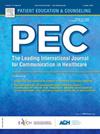Patient, care partner, and provider voice in treatment decision-making for non-small cell lung cancer
IF 2.9
2区 医学
Q2 PUBLIC, ENVIRONMENTAL & OCCUPATIONAL HEALTH
引用次数: 0
Abstract
Objectives
Describe the treatment attributes that patients, care partners, and clinicians prioritize when making decisions about non-small cell lung cancer (NSCLC) as well as each group’s perspectives regarding shared decision-making (SDM).
Materials and Methods
Cross-sectional online surveys were conducted between March andMay 2023. Adult patients and care partners were recruited from Inspire, a closed online health community, and clinicians (oncologists, nurse practitioners, physician assistants) were recruited separately from M3 Global Research databases. Survey questions were informed by a literature review, interviews, and steering committee input.
Results
160 patients and 30 care partners (0.3 % of those invited and 15 % of those who responded to the email invitation), and 150 clinicians (5 % of those invited and 43 % of those who responded to the email invitation) completed the surveys. Across all groups, expected overall survival was the most important treatment attribute. Quality of life, ranked second by patients and care partners, was ranked fourth by clinicians. When asked about SDM, 11 % of patients with early-stage NSCLC and 12 % of those with advanced disease wanted their doctor to make treatment decisions after considering their opinion. However, 53 % of clinicians thought patients preferred that they make the final decision in later disease stages.
Conclusion
Patients with NSCLC, care partners, and clinicians generally agreed on the most important treatment attributes. However, aligning on SDM practices could help achieve more effective NSCLC management.
Practice Implications
Our study reinforces the relevance of SDM in NSCLC; however, some patients who wish for greater involvement in decisions may find their preferences overlooked.
非小细胞肺癌治疗决策中的患者、护理伙伴和提供者意见
目的描述患者、护理伙伴和临床医生在对非小细胞肺癌(NSCLC)做出决策时优先考虑的治疗属性,以及每组对共同决策(SDM)的看法。资料与方法横断面在线调查于2023年3月至5月进行。成年患者和护理伙伴从Inspire(一个封闭的在线卫生社区)中招募,临床医生(肿瘤学家、执业护士、医师助理)分别从M3 Global Research数据库中招募。调查问题是通过文献回顾、访谈和指导委员会的输入来确定的。结果160名患者和30名护理伙伴(受邀者中占0.3% %,回复邮件者中占15% %)以及150名临床医生(受邀者中占5% %,回复邮件者中占43% %)完成了调查。在所有组中,预期总生存率是最重要的治疗属性。生活质量被患者和护理伙伴排在第二位,被临床医生排在第四位。当被问及SDM时,11. %的早期NSCLC患者和12. %的晚期NSCLC患者希望医生在考虑他们的意见后做出治疗决定。然而,53% %的临床医生认为患者更倾向于在疾病晚期做出最终决定。结论非小细胞肺癌患者、护理伙伴和临床医生对最重要的治疗属性基本一致。然而,统一SDM实践可以帮助实现更有效的非小细胞肺癌管理。实践意义我们的研究强化了SDM在NSCLC中的相关性;然而,一些希望更多参与决策的患者可能会发现他们的偏好被忽视了。
本文章由计算机程序翻译,如有差异,请以英文原文为准。
求助全文
约1分钟内获得全文
求助全文
来源期刊

Patient Education and Counseling
医学-公共卫生、环境卫生与职业卫生
CiteScore
5.60
自引率
11.40%
发文量
384
审稿时长
46 days
期刊介绍:
Patient Education and Counseling is an interdisciplinary, international journal for patient education and health promotion researchers, managers and clinicians. The journal seeks to explore and elucidate the educational, counseling and communication models in health care. Its aim is to provide a forum for fundamental as well as applied research, and to promote the study of organizational issues involved with the delivery of patient education, counseling, health promotion services and training models in improving communication between providers and patients.
 求助内容:
求助内容: 应助结果提醒方式:
应助结果提醒方式:


